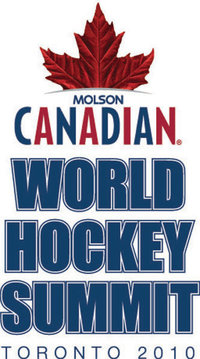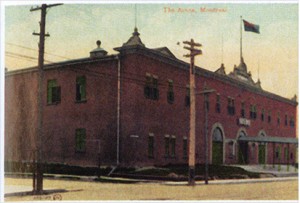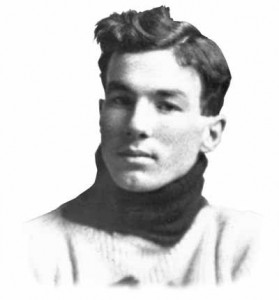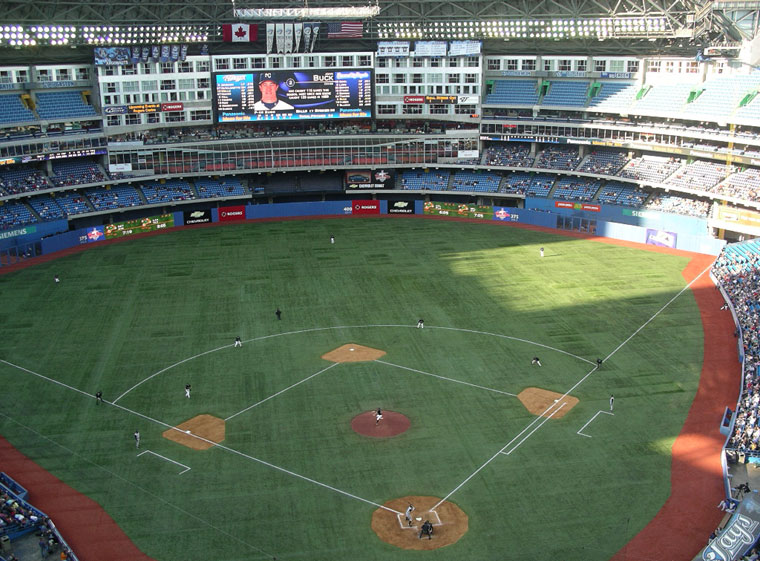Speed demon: why Daniel Catenacci is the sleeper of the NHL draft
The National Hockey League’s Central Scouting Bureau released its final rankings for draft eligible amateur players on Monday. Not surprisingly, the top three North American skaters were Ryan Nugent-Hopkins, Gabriel Landeskog and Jonathan Huberdeau.
But those high picks are only a small part of the draft. What if your team has a low pick, or maybe no picks in the first round, who should you be hoping to get for that instant impact? Who is the sleeper of the 2011 draft?
Look no further than Daniel Catenacci of the Sault Ste. Marie Greyhounds.
The five-foot-10 skater from Newmarket, Ont., was ranked 37th in the Central Scouting’s final report on domestic skaters, up from 43rd in January's midterm rankings.
When you mix in international skaters and goaltenders that means Catenacci could go as late as the third round of the NHL draft on June 24.
It’s an understandable fate when you look at the 18-year-old’s numbers from the Ontario Hockey League. Last season he had 26 goals and 45 assists with a minus-5 +/- rating and 117 penalty minutes. The year before that, Catenacci was a non-factor with 10 goals and 20 assists.
But Catenacci has a quality that most of his draft classmen lack: speed.
The above video is from the Canadian Hockey League Top Prospects game at Toronto’s Air Canada Centre on Jan. 19, when Catenacci put the afterburners on and broke open the scoring for Team Orr while shorthanded.
In that video it’s obvious that he’s by far the fastest player on the ice. In fact, he usually is, but that clip is exceptional. The guys in his dust are the best and brightest the CHL has to offer and yet they can’t catch him.
Earlier that week I attended the Next Testing session at the Mastercard Centre for Hockey Excellence where the Top Prospects were put through their paces. Dead sprints, agility tests, you name it, they did it.
Again, Catenacci was, by far, the best skater, outmanoeuvring and outpacing the other 40 or so players being tested. (You can see some of his performance here.)
At the Top Prospects skills competition, Catenacci was name the fastest skater, turning in a performance way ahead of the pack.
Why does all this matter? Because the thing that strikes most rookies when entering the NHL is the speed of the game. For their entire careers they’ve been one of the top players on their team, if not the best, and that usually includes being the best skater. But coming to the NHL they’ve finally found their level, and that doesn’t hold true anymore.
As a result, most rookies spend their first year as a professional trying to improve their skating and catching up to their teammates and opponents. It hurts their vision of the ice and impacts their ability to make plays.
Catenacci, presumably, won’t have that kind of trouble, since he should be able to keep pace.
His speed will also be an asset as he finds his role in the NHL. After all, what assignments are rookies usually given? Penalty killing, checking lines, defensive work and all with limited ice time. In all three cases, a fast skater will, pardon the pun, excel.
Although he’s not the prolific scorer that a Nugent-Hopkins, Landeskog or Huberdeau will be, Daniel Catenacci’s speed is an undeniable advantage that will make him NHL-ready before most of his peers and, hopefully, will increase his value come draft day. Certainly, any team will be lucky to have him on their depth charts.
World Hockey Summit: Day 1
 As I mentioned on my Twitter feed, I will be attending the 2010 World Hockey Summit this week, with lots of LiveTweeting on my feed and daily blog posts summarizing what I’ve learned.
As I mentioned on my Twitter feed, I will be attending the 2010 World Hockey Summit this week, with lots of LiveTweeting on my feed and daily blog posts summarizing what I’ve learned.
Hockey Canada is organizing the conference, bringing together hockey organizers, players and coaches from around the world to discuss the future of the game and improve on safety.
In the words of Hockey Canada President Bob Nicholson, the Summit will “provide an inclusive forum to table the most pressing questions surrounding our game and work together to find implementable solutions.”
Day 1 was very straightforward. It was basically clear from nine until five, giving all the attendees a chance to register and settle into their accommodations in downtown Toronto.
Tonight there will be a Hot Stove Session at the Hockey Hall of Fame where four panels rotate from room to room, discussing Contracts and Transfers, Agents’ Role in Working with Young Players, State of the Game and Comparisons of the International and North American Game.
Unfortunately, I’ve got previous commitments for tonight, so I’ll be missing out on those talks. They do sound very interesting though, and I’ll try to get my hands on a recap of the discussions to share here.
Tomorrow will start with a continental breakfast at the Air Canada Centre, home of the Toronto Maple Leafs and the National Hockey League’s Canadian office. There’ll then be a three hour session on Player Skills Development.
At one in the afternoon, Rene Fasel, the President of the International Ice Hockey Federation, is going to have a half-hour Q+A period.
Next up is the session that I am most interested in: Junior Development in the Hockey World. The reason is fairly obvious – as junior hockey editorial assistant for the Canadian Press, this is my wheelhouse.
It’s going to be a lot of fun and interesting week. Please, check back here tomorrow night or my Twitter feed throughout the day to see what it’s all about.
My latest for Hockey Prime Time

Recognize this place? It's one of my top 10 arenas in NHL history. Hover your cursor over the picture for the answer.
As long-time readers of this blog know, I’m involved with a hockey website called HockeyPrimeTime.com. It’s a great site that offers up news and analysis of the National Hockey League as well as hockey around the world.
Normally I’d be writing some notebooks on the comings and goings of the NHL’s Northeast division.
However, since there’s no hockey on right now we’ve been putting together a series of Top 10 lists. I’ve contributed two articles to the project and I’m really proud of both of them.
Most recent was my list of the Top 10 Arenas in Hockey History. A few recent rinks that made the list are Toronto’s Air Canada Centre, Detroit’s Joe Louis Arena and Philadelphia’s Spectrum.
My other Top 10 list was posted about a week ago and breaks down the Top 10 Most Influential Individuals in NHL history. I had a blast writing it. Like my work with Canada’s Sports Hall of Fame I got to combine my interest in history with my love of hockey.

Recognize this guy? He's #9 on my list of the most influential people in NHL history. Hover your cursor over the picture for his name.
I think my list of ten influential people will surprise some people and hopefully it’ll also introduce people to some players and builders who don’t get enough credit for shaping the modern NHL. I also feel that some people will be surprised at who is at the top of the list as the most influential man in NHL history.
In any event, it was a lot of fun putting these lists together.
What do you think the most significant hockey arenas are in hockey history?
What about influential people? Do you think I missed anyone?
Stadium Review: Rogers Centre
As regular readers of this blog know, I’ve been to several ballparks in this past year. Last summer I went to Detroit’s Comerica Park, while this July I went to New York City’s New Yankee Stadium and Citifield.
However, I had never considered reviewing the Rogers Centre, the ballpark in my hometown Toronto. Not because it’s unworthy, but because I was worried that I would be too hard on a stadium that has become a scapegoat for the attendance woes of the Toronto Blue Jays as well as the Canadian Football League’s Toronto Argonauts.
But on Tuesday night I returned to the former SkyDome after a month without attending a Jays home game and I realized, hey, this isn’t so bad.
First of all, I was buoyed by the recent ESPN study that found the Rogers Centre to be one of the cleanest stadiums in all of professional sports, a small club that includes the Air Canada Centre, home of the Toronto Maple Leafs and Toronto Raptors. There are only nine other venues that have spotless health records.
Also, after my 45 minute subway ride to Citifield in Queens, New York, I have found a new appreciation for the downtown location of the Rogers Centre. It’s a five minute walk through a dedicated passage from Union Station, giving the ballpark access to the Toronto Transit Commission and the provincial GO Trains.
The neighbourhood is ideal for out-of-towners hoping to kill some time before the opening pitch. Right beside the ballpark is the CN Tower, the second tallest structure in the world. Across the street is the Steam Whistle Brewery that serves one free sample beer to any visitor over the age of 19 and also has a variety of antique train engines.
Although it lacks the charm of the newer retro-styled parks like Citifield, Comerica and New Yankee Stadium, the Rogers Centre has all the same amenities with large and conveniently placed washrooms that are easier to find than the facilities at the American stadiums.
Of course, the former SkyDome’s big draw is its roof. Although it seems like a quaint 1980s concept, the retractable dome remains practical in a city that can have snow in April. The closed dome also means that the stadium is useful all year around.
Don’t get me wrong, there Rogers Centre does have its drawbacks, especially the feeling that it is always half-empty. It can’t be helped - its seating capacity is fifth largest in Major League Baseball but Toronto averages the fourth smallest crowd in the Majors. As a result, the stadium seems deserted for most games.
As far as service goes, the staff at concessions and in the stands are fine. However, the public announcer and the rest of the in-game entertainment seem desperate to energize the staid Toronto crowd. They don’t seem to realize that Torontonians are almost always quiet at concerts, festivals and other events. It’s just in the city’s character.
Unfortunately, this year they’ve tried to boost the crowd’s excitement by cranking the music as loudly as possible, stifling conversation and drowning out any attempts at chants or cheers from the crowd. The stadium may not be quiet, but the crowd is. It distracts from the action on the field and takes away from baseball’s pastoral roots.
Toronto’s Rogers Centre is far from perfect, but it’s also not the worst ballpark I’ve ever been to. It’s accessible by public transit and is reasonably priced. It’s clean and family friendly. Unlike Fenway Park or Yankee Stadium it’s better suited to locals than visiting fans, but that’s not a serious offence for a stadium. It serves the city of Toronto admirably.
